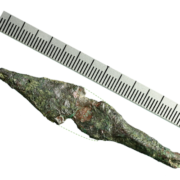The History of The Temple Mount in 12 Objects: #4 The Early Second Temple Period
Rejoice! Our series – The Temple Mount in 12 objects is back!
We turn our attention now to the Persian Period.
The Persian Period begins in 539 BCE, with the conquest of Babylon by Cyrus the Great and ends in 333 BCE, when the forces of Alexander the Great marched through Judea.
The Judean province, well removed from the raging battlegrounds, passed (almost) peacefully from one empire to the next, a fact no doubt appreciated by contemporary inhabitants, but the lack of destruction layers makes for quite a challenge for the archaeologists.
Consequentially, while some pottery sherds in our lab may be of the Persian Period, but may just as well belong to the preceding or following era, there are only a few pieces which can be labeled as definitively dating to the Persian Period, and hence the focus for this post:
For the Persian Period, we’ve elected to showcase not a single artifact, but a group. The sherds in this picture all come from locally manufactured kraters, or deep-bowls, possibly imitating similar Mesopotamian vessels, with a triangular-impressed motif, reminiscent of cuneiform writing signs. The sherds in this picture comprise in of themselves a significant percentage of all of our pottery from the period.
Other local ware from the early Persian Period continued simple styles from the Iron Age, while later in the period, some “early sparrows” show styles which will continue into the Hellenistic era.
And last of all, looking westward, black-glazed pottery from Attica, Greece tells the story of commerce with the Aegean region.
The First Temple was destroyed by Babylonian forces in 586 BCE. Forty eight years later, under permit by Cyrus, king of the Persian Empire, work on the Second Temple begun but was delayed time and again, to be completed only at 515 BCE.
The biblical account (Esd. 3:12, Hag. 2:3) focuses on the bitter disappointment felt by the returnees when comparing the newly built Temple to the First one, but the very fact that attendees had seen the First Temple first-hand, tells us that they would have no trouble in placing the new Temple in the same location.
The book of Nehemiah, who arrived in Jerusalem in 444 BCE, tells of the rebuilding of the walls of Jerusalem, along with the Birah – a term whose exact meaning is elusive, but is likely related to the Temple Mount. Much like the First Temple, the Eastern city wall and the walls of the Temple Mount were likely one and the same. The Water Gate, mentioned in Nehemiah 8 as the gathering place for the people to hear the reading of the Torah, was probably situated in this wall. The Ophel area, south of the Temple, likely resumed its role as the seat of the administration. Some other gates mentioned by Nehemiah may have belonged to the Temple compound: The East gate, Horse Gate, Sheep Gate, Jeshanah Gate, and on the West: The Fish Gate and the Valley Gate. the fortified Tower of the Hundred and Tower of Hananel seem to be in the vicinity as well.
During the Persian Period, Jerusalem joined the trend that would revolutionize the world of commerce. No longer would merchants be forced to weigh bits of precious metal on the scales at every transaction. The central government would henceforth standardize these pieces of gold, silver and bronze, and put its official stamp upon them. The first Greek coins were brought to Jerusalem in the 6th century BCE. By the 4th Century BCE, The Jerusalem mint was producing the first “Jewish” coins. These tiny silver coins are a rare find in archaeological excavations, and yet we’ve found five so far. Read more about our rare YHD coins
In summary, even though the finds from this period are sparse, considering the tranquil nature of the period, that small amount (especially the coins), may yet still echo the work of an administrative center on the Temple Mount. The pottery with which we opened shows new cultural influences which the returnees picked up in their short exile in Babylon and Persia, and hint at things to come, as cultural focuses change from East to West.
Join us next time as we explore the Hellenistic and Hasmonean Eras!
Discover more from The Temple Mount Sifting Project
Subscribe to get the latest posts sent to your email.











Leave a Reply
Want to join the discussion?Feel free to contribute!